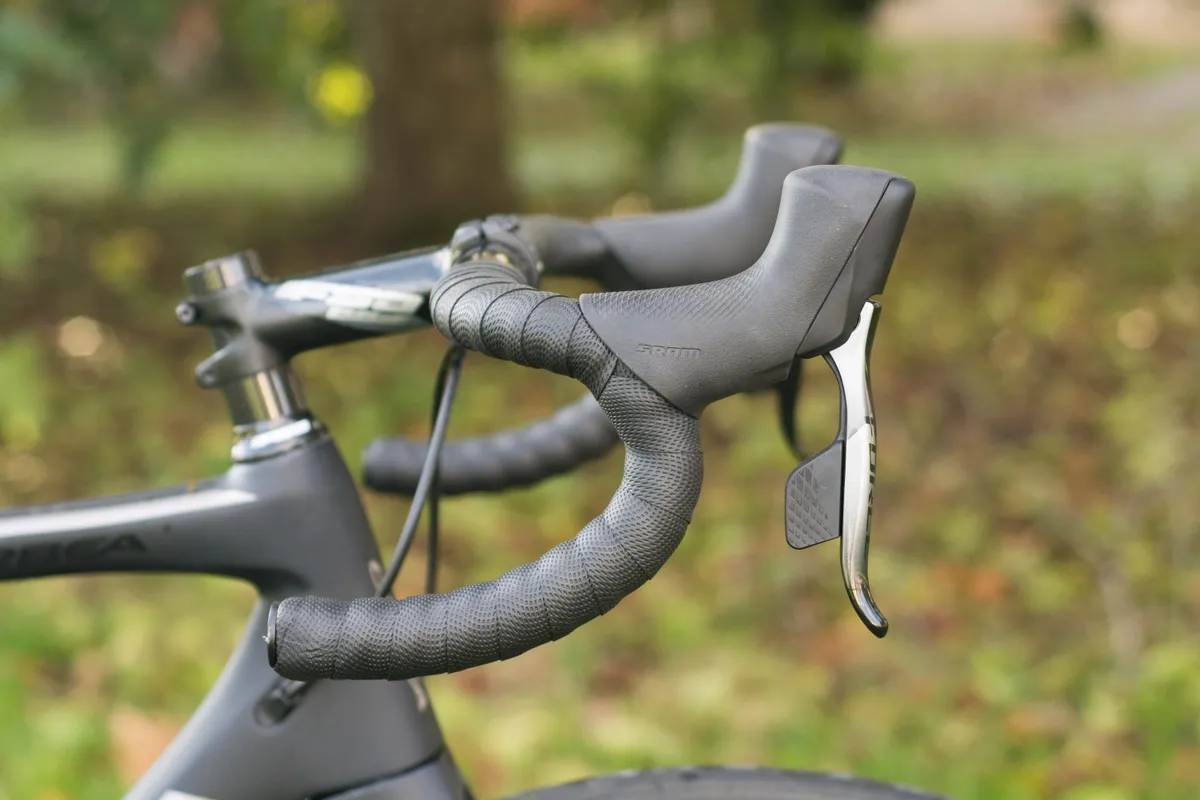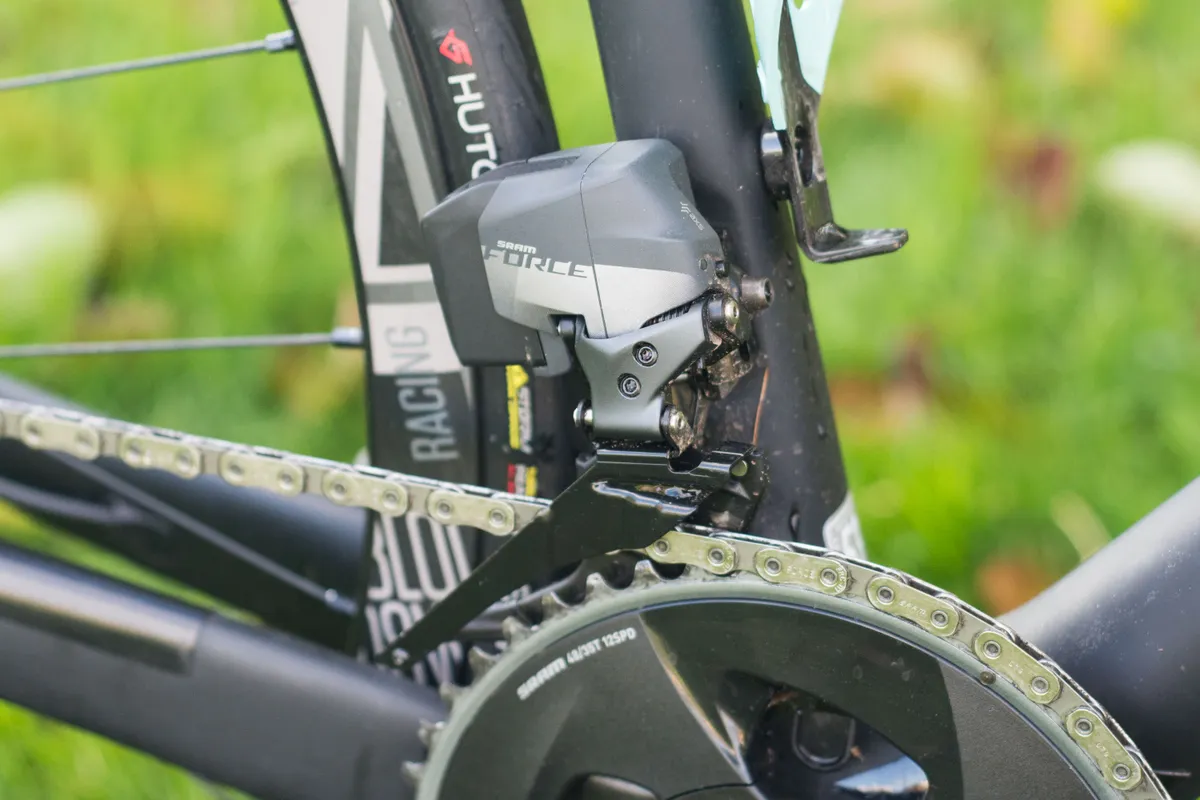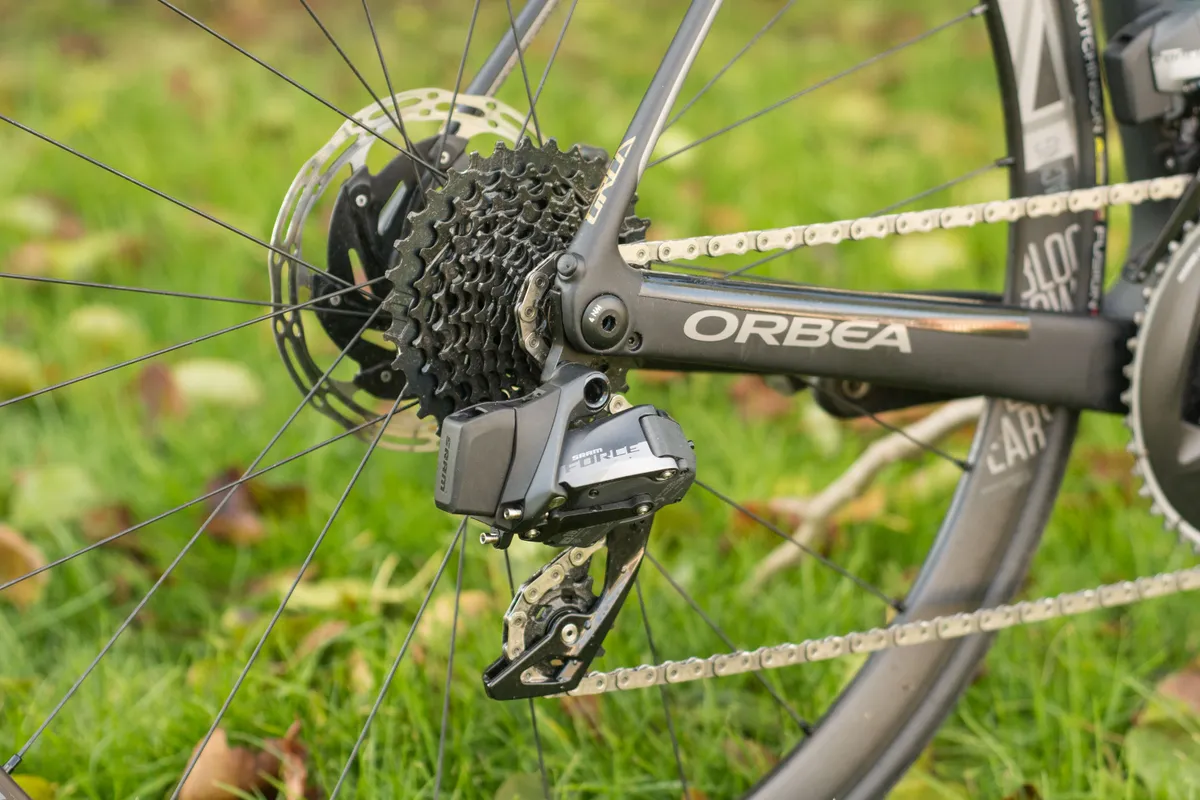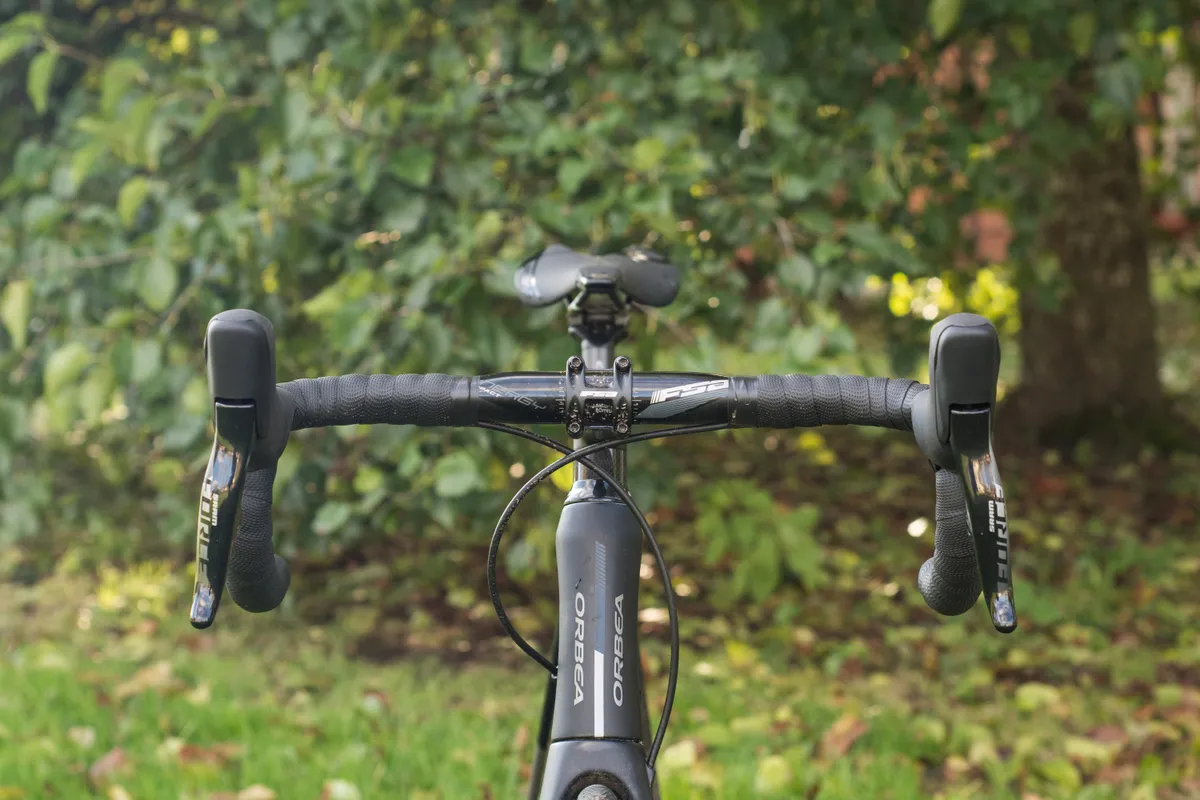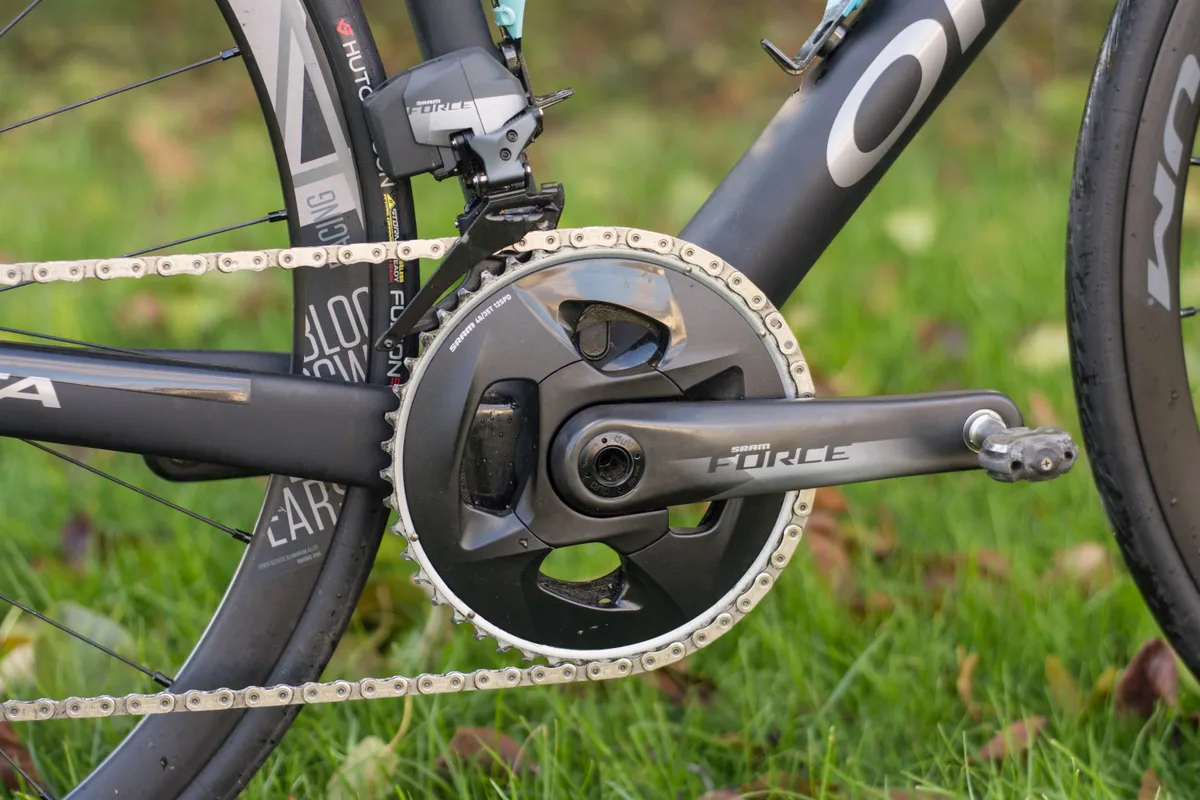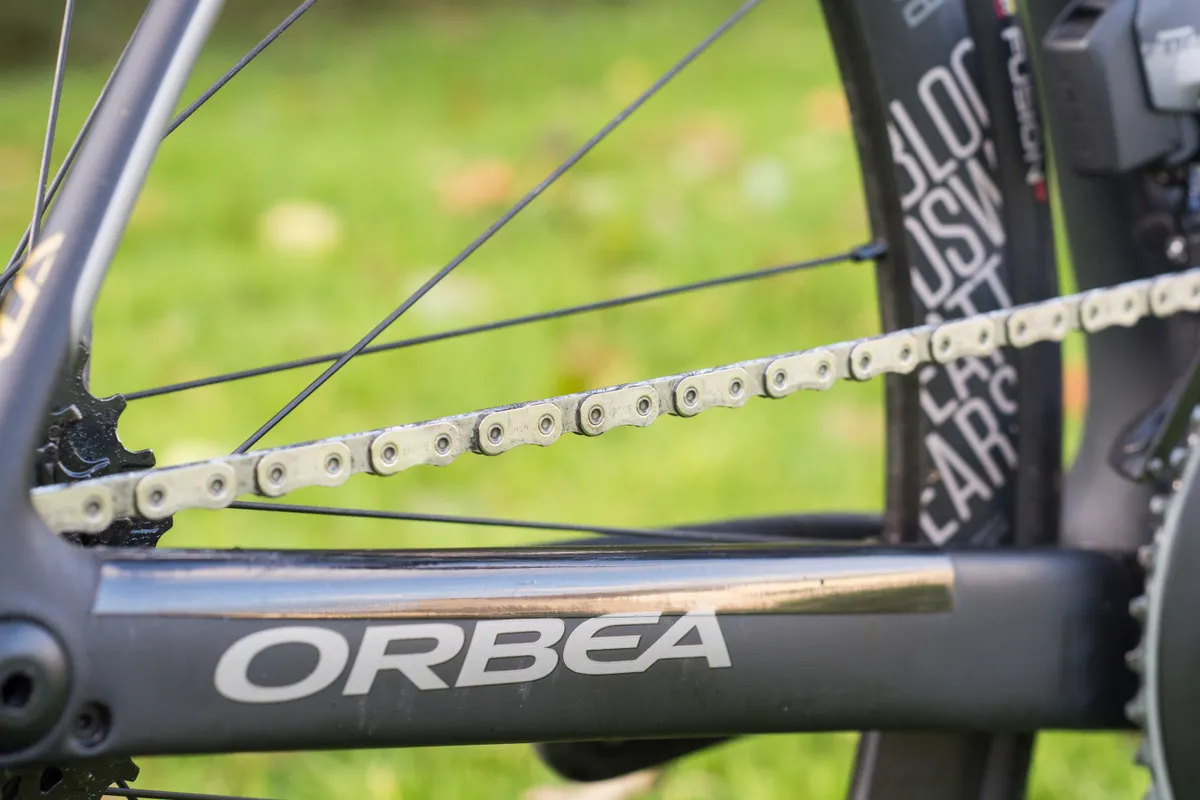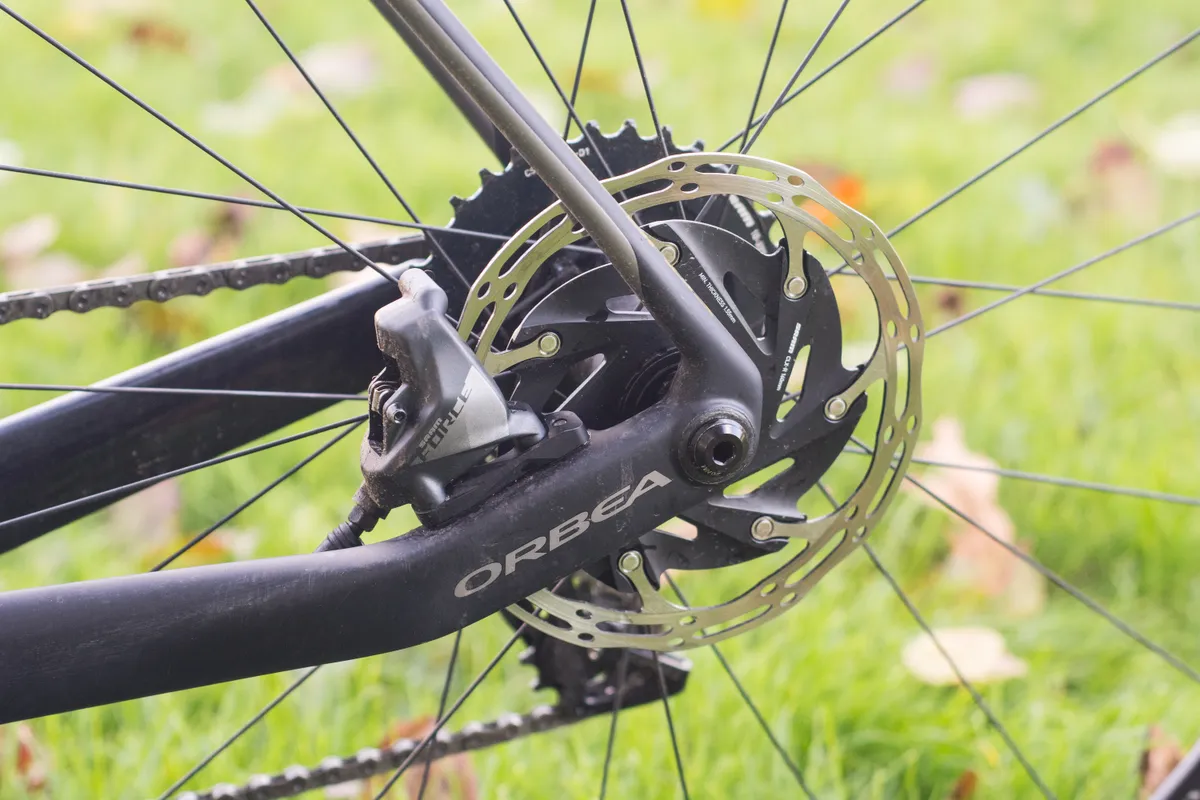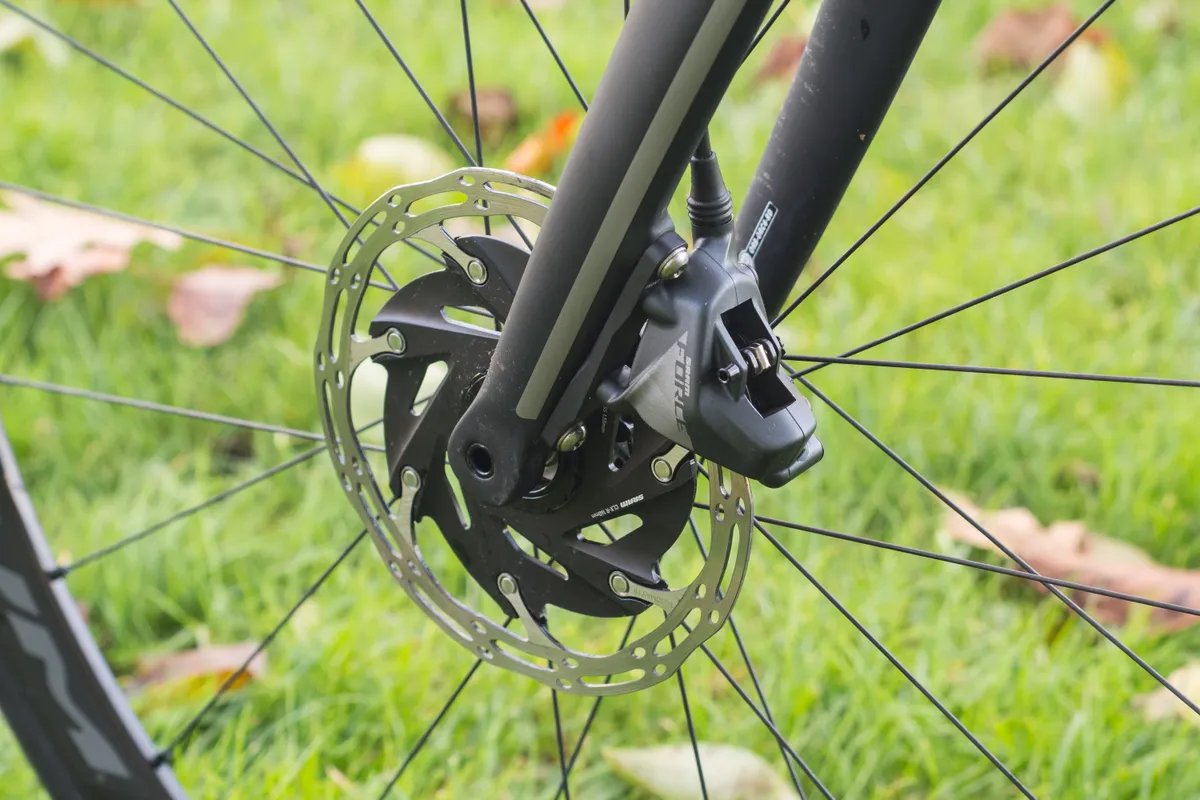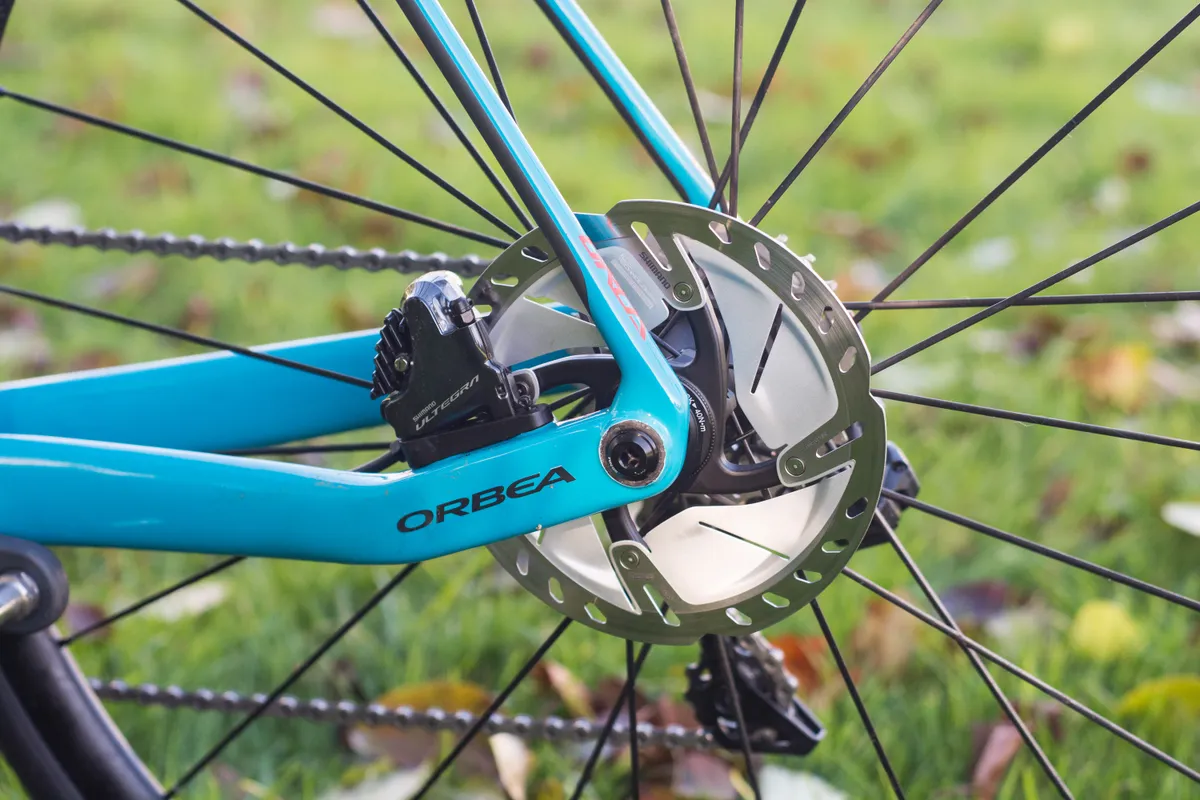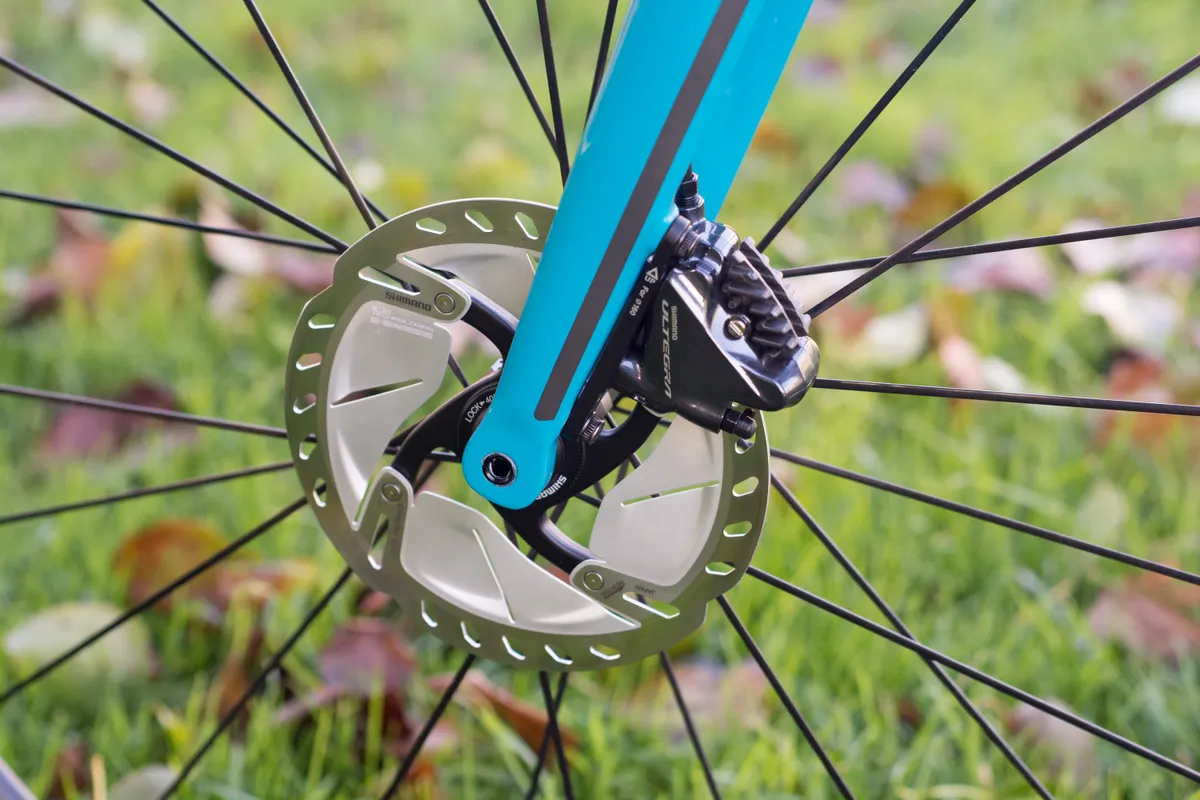Update 24/01/2024: Read our head-to-head of the latest Shimano Ultegra Di2 R8100 and SRAM Force AXS groupsets to find out which is best.
SRAM Force eTap AXS and Shimano Ultegra Di2 are both hugely capable electronic groupsets that offer much of the experience of their respective makers’ Red and Dura-Ace flagships, at considerably more affordable prices.
With a little help from the good people at Orbea, who laid on near-identical Orca test bikes, I set out to find out whether SRAM Force eTAP AXS or Shimano Ultegra Di2 is better.
- Road bike groupsets: everything you need to know
- Best road bikes 2020: how to choose the right one for you
R8000-generation Ultegra Di2 has been around since 2017 while Force eTap AXS launched in early 2019.
While both SRAM and Shimano offer rim brake variants of their respective groupsets, I’ve put the disc versions of Force eTap AXS (HRD) and Ultegra Di2 (R8070) head-to-head as they’re the ones most often seen on new bikes.
SRAM Force eTap AXS key features
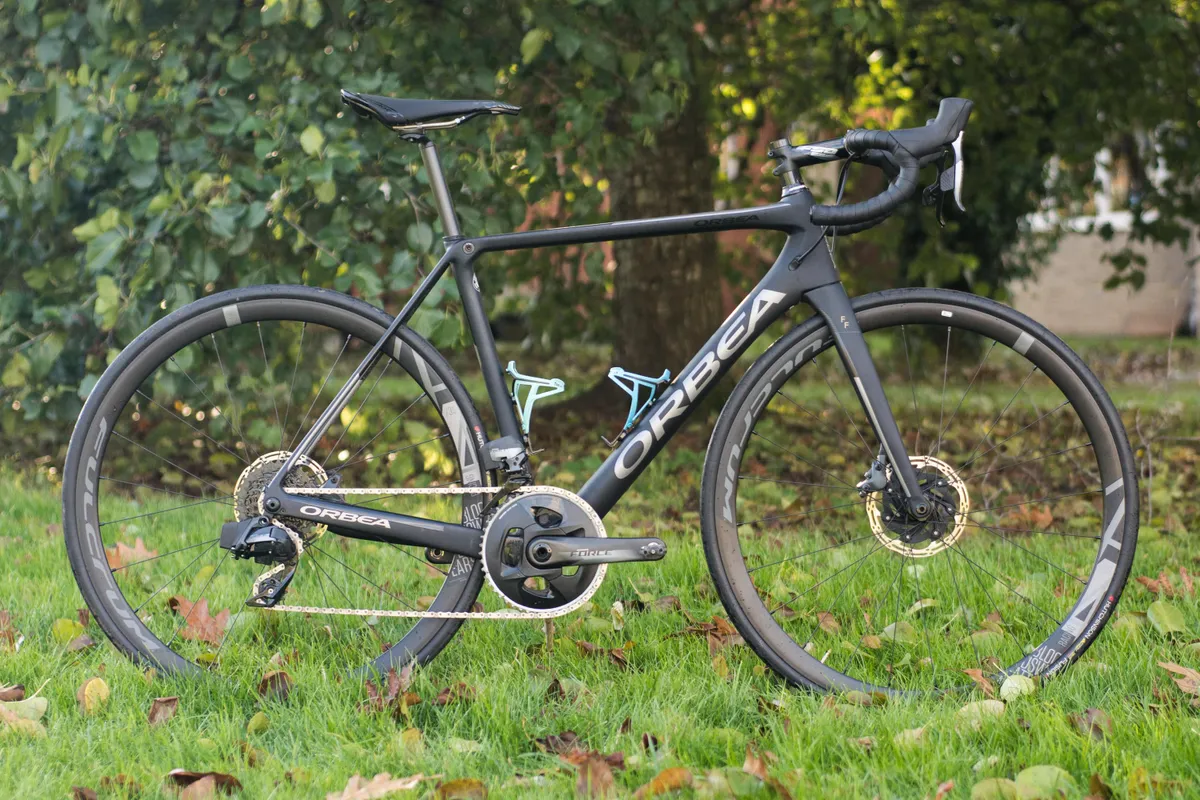
- Fully-wireless, electronic 12-speed groupset
- Hydraulic disc brake and mechanical rim brake options
- New crank and cassette ratios optimised around extra gear and cassettes with a 10t cog
- Designed for 1× or 2×
- XDR driver in place of a conventional freehub
- Shifting via one paddle on each lever
- Removable rechargeable batteries on derailleurs, coin cells in shifters
- Customisation and battery monitoring available via phone app (Android or iOS)
Shimano Ultegra Di2 key features

- Wired, electronic 11-speed groupset
- Hydraulic disc brake and mechanical rim brake options
- Conventional double and compact double crank options
- 2×-only but compatible with GRX 1× components
- Shifting via two buttons on each lever, mimicking mechanical groupsets
- Single large rechargeable battery usually concealed within seat post
- Customisation and troubleshooting via wired PC connection (iOS not available) or tablet/phone app using Bluetooth connection (requires additional wireless adapter)
AXS vs. Di2: ergonomics, adjustability and shifting
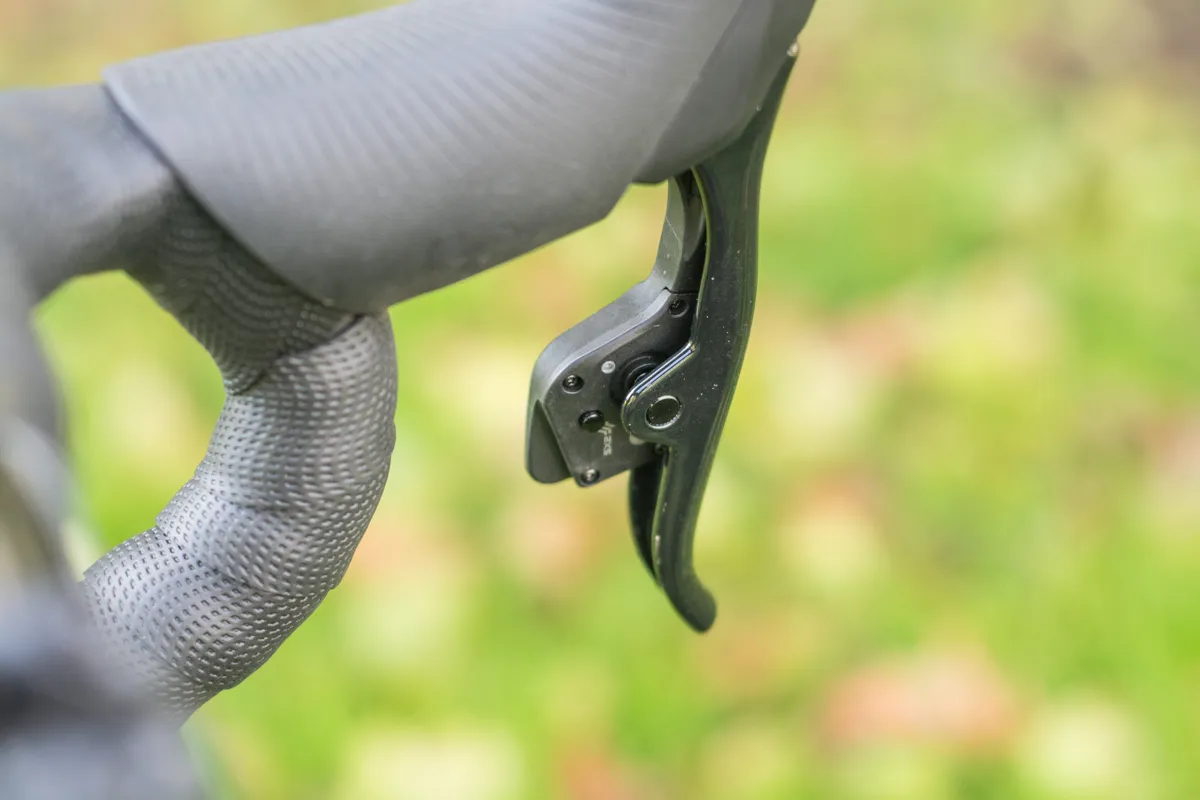
SRAM’s mechanical groupsets use DoubleTap, a system that relies on two-stage paddles mounted behind the brake levers. eTap is visually similar, but the paddles are simple switches, with the default arrangement being: right paddle for rear derailleur upshifts; left paddle for rear derailleur downshifts; both paddles simultaneously for front derailleur shifts.
It’s a system that’s very easy to explain to the uninitiated, even more so if you activate sequential shifting (explained below), as that means you don’t have to think about front shifting at all.
Shimano’s default Di2 shifting arrangement mimics mechanical shifting in that there are separate buttons on each lever for upshifts and downshifts. However, unlike the mechanical levers, the brake lever doesn’t move sideways to shift – braking and changing gear are completely separate.
Shimano has long been criticised for its comparatively undifferentiated Di2 shift buttons. That hasn’t really changed – they’re still very close together and not easily felt through thick gloves – but, like anything, you get used to it.
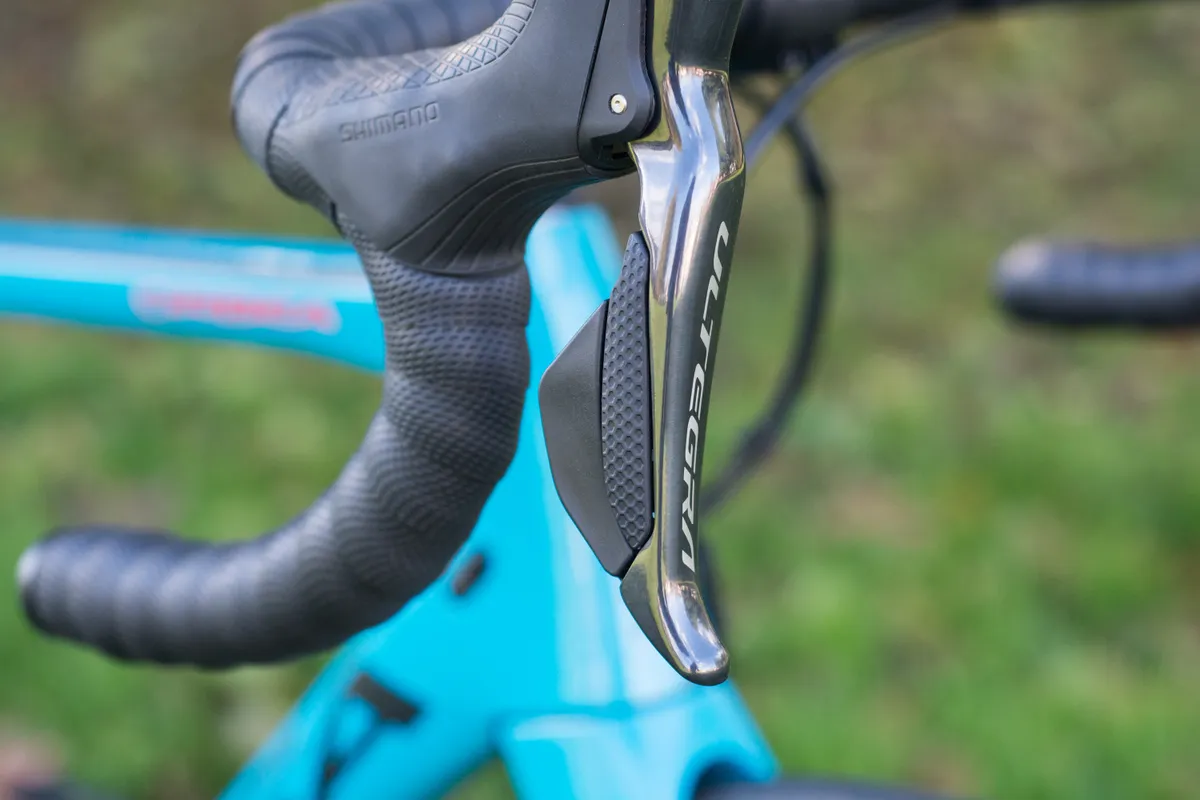
The buttons themselves have a pleasantly damped feel to them, arguably nicer than the plasticky click of eTap’s paddles. As the system doesn’t have to decide if you meant to press buttons simultaneously the way it does with eTap, the front shifting is impressively quick, and remarkably smooth with it.
Both systems have the option to take care of front shifting for the rider, allowing you to simply shift up or down a gear.
In this mode, which SRAM calls ‘sequential shifting’ and Shimano ‘synchronised shifting’ (or synchro), the decision about which upshifts and downshifts should include a front derailleur shift is taken by the system. This happens at predetermined points that allow a smooth progression between gears.
The precise behaviour of both systems can be customised via the brands’ respective apps.
Alternatively, in ‘compensation’ mode (SRAM) or semi-synchronised mode (Shimano), you can shift the front yourself, but the rear derailleur shifts at the same time to reduce the size of the jump between gears.
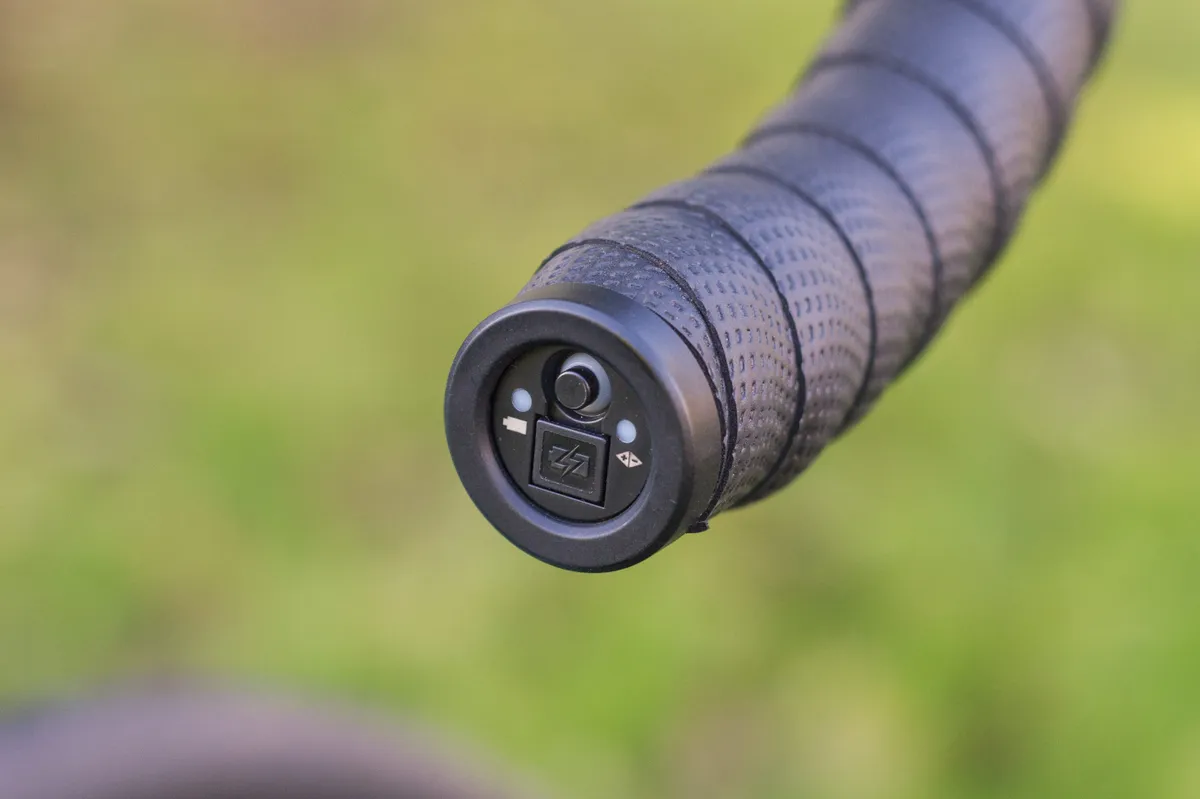
Both groupsets also let you change overall shifting arrangements (for example reversing up- and down shifts) but Shimano has a small edge here in that there’s a hidden button on the top of each shifter. These can be assigned to any number of things, including controlling third party devices such as Garmin GPSs.
Incidentally, both groupsets allow you to add additional, separate buttons referred to as satellite/sprint shifters (Shimano) or Blips (SRAM).
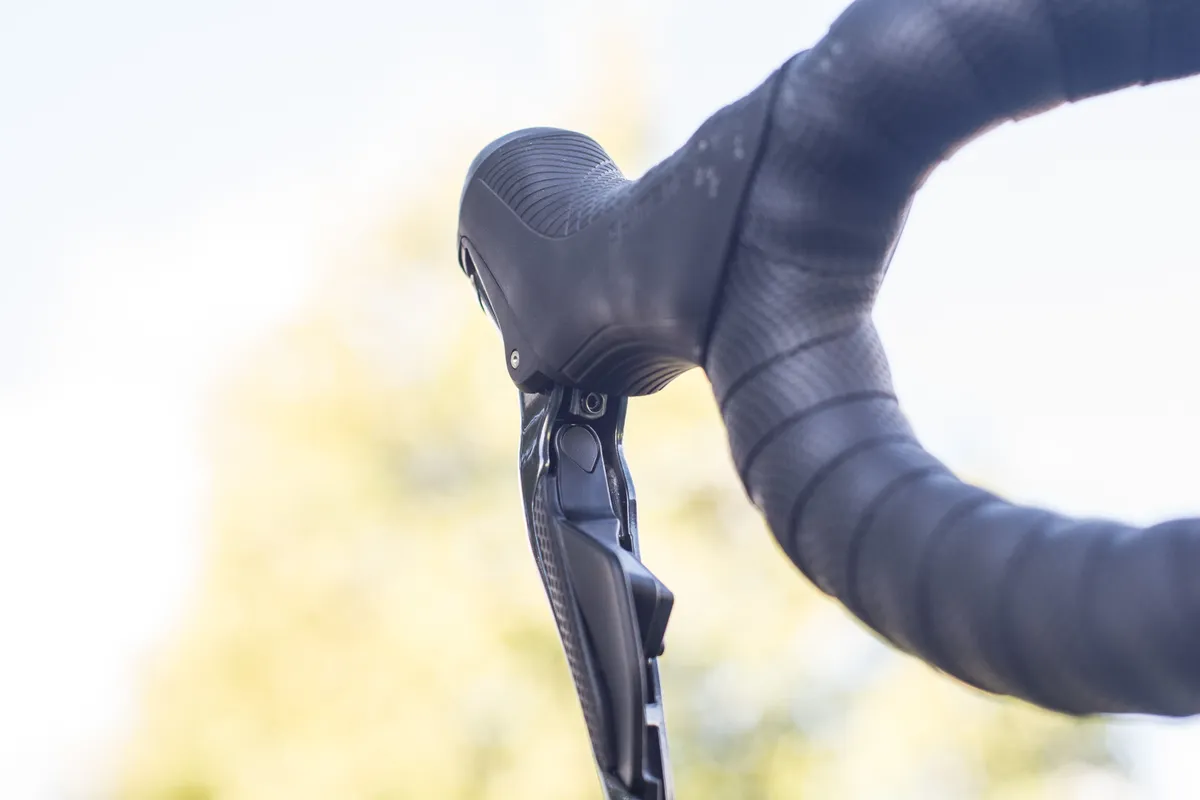
Both also offer lever reach and bite point adjustment via screws on the lever body.
Which is better? It’s a draw. SRAM deserves praise for its intuitive shifting logic, Shimano for its quick and smooth front shifting, but both groupsets perform really well in the real world.
Di2 vs. AXS: aesthetics and packaging
This section comes with the caveat that aesthetics are highly subjective, but there are some clear differences between the two groupsets that are worth discussing.
SRAM Force AXS eTap has no gear cables, so the overall look is incredibly clean. The aesthetic is very slick and modern, which really suits some bikes (particularly bleeding edge aero bikes, which route the hydraulic hoses fully internally).
Saying that, the finish is quite muted up close, with surface texturing that’s somewhat plasticky in appearance.
The two-tone crank shares design language with the more elaborate Red design, but it looks a good deal cheaper. Likewise, Force lacks any of the shiny metal parts of the flagship groupset.
SRAM’s electronic derailleurs are quite substantial because of the need for separate batteries in a wireless system.
The hydraulic hoods are similar chunky as they house a hydraulic master cylinder. Their distinctive square profile adds visual weight to the front of the bike and offers plenty of space to rest your hands on.
It also gives the bike a slightly bull-horned look, which I don’t love, but that’s a matter of taste.
Some bike makers do a much better job of hiding cables than others but fundamentally, Shimano Di2 is messier than eTap because everything is connected via physical cables and these need to be routed from the levers to the derailleurs, via the cockpit and the frame.
At the same time, Shimano has done an incredible job of shrinking down its hydraulic innards, making levers with no strange excrescences.
We’re looking at the Di2 version for this test, but the packaging is particularly impressive on the mechanical shifting/hydraulic braking R8020 groupset, where the levers have to house both a shifting mechanism and a master cylinder.
The Di2 version is even more svelte, with a side profile that’s rather elegant, and certainly sleeker than that of SRAM’s chunky hoods.
Ultegra’s finish is very slick too, looking nearly as expensive as its Dura-Ace big brother. The crank is a lovely looking thing, with lines that manage to be at once muscular and dainty.
The finish is relatively easy to damage, however – my heels-in pedalling style quickly stripped a small section of grey off with a little help from winter muck.
Which is better? It’s a draw. eTap is tidier overall, but Shimano’s levers are more elegant and the whole groupset's finish looks more expensive.
AXS vs. Di2: gearing and component options
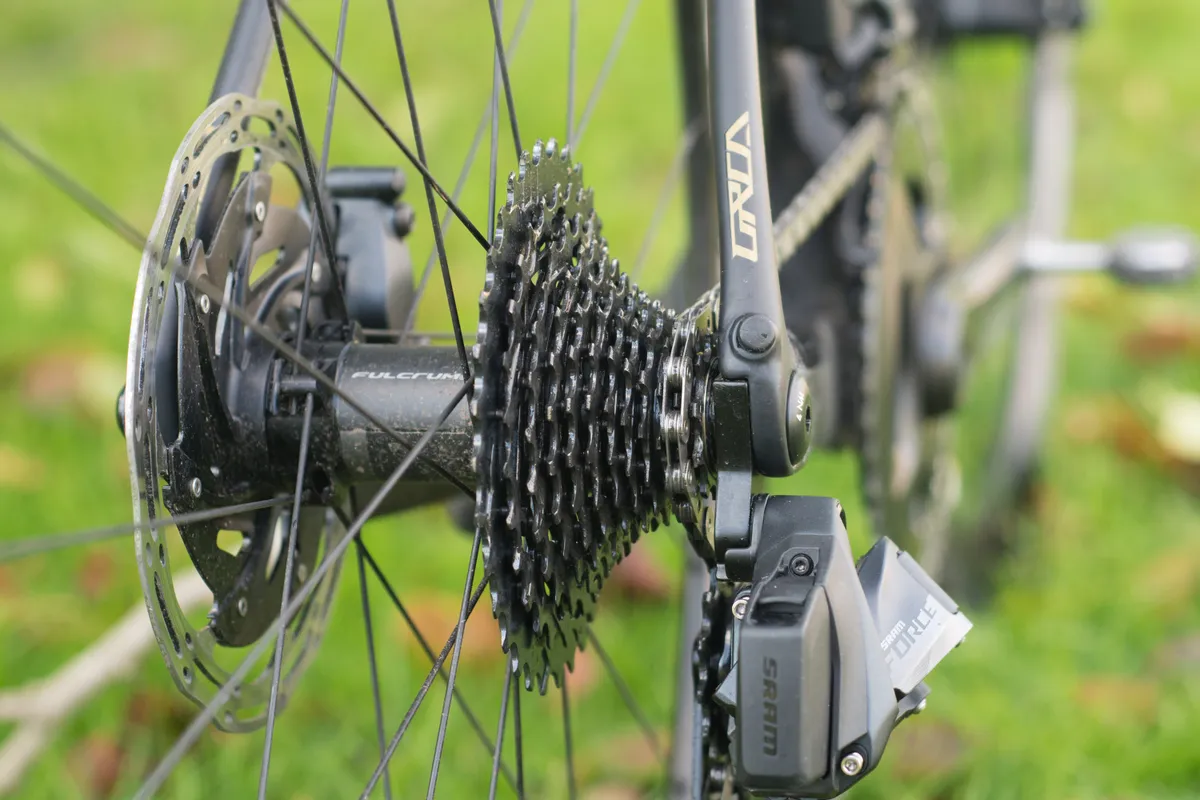
SRAM debuted a new approach to gearing with its AXS groupsets that it calls X-Range, doing away with the traditional standard double and compact ratios in favour of more closely spaced chainrings, matched to wider range cassettes.
With a 10t small cog on its 12-speed cassettes, SRAM now offers two double crankset ratios at Force level: 46/33t and 48/35t, both with a 13t difference between inner and outer chainrings. The top-tier Red groupset also gets a 50/37t option.
Force eTap AXS offers 1× too, and Force cranks are available with chainrings ranging from 36t up to 48t. AXS groupsets use SRAM's DUB bottom bracket design by default, which works with virtually all frames. The cranks are also available with a 24mm (GXP) spindle to fit Trek BB90 and 70mm Italian threaded frames.
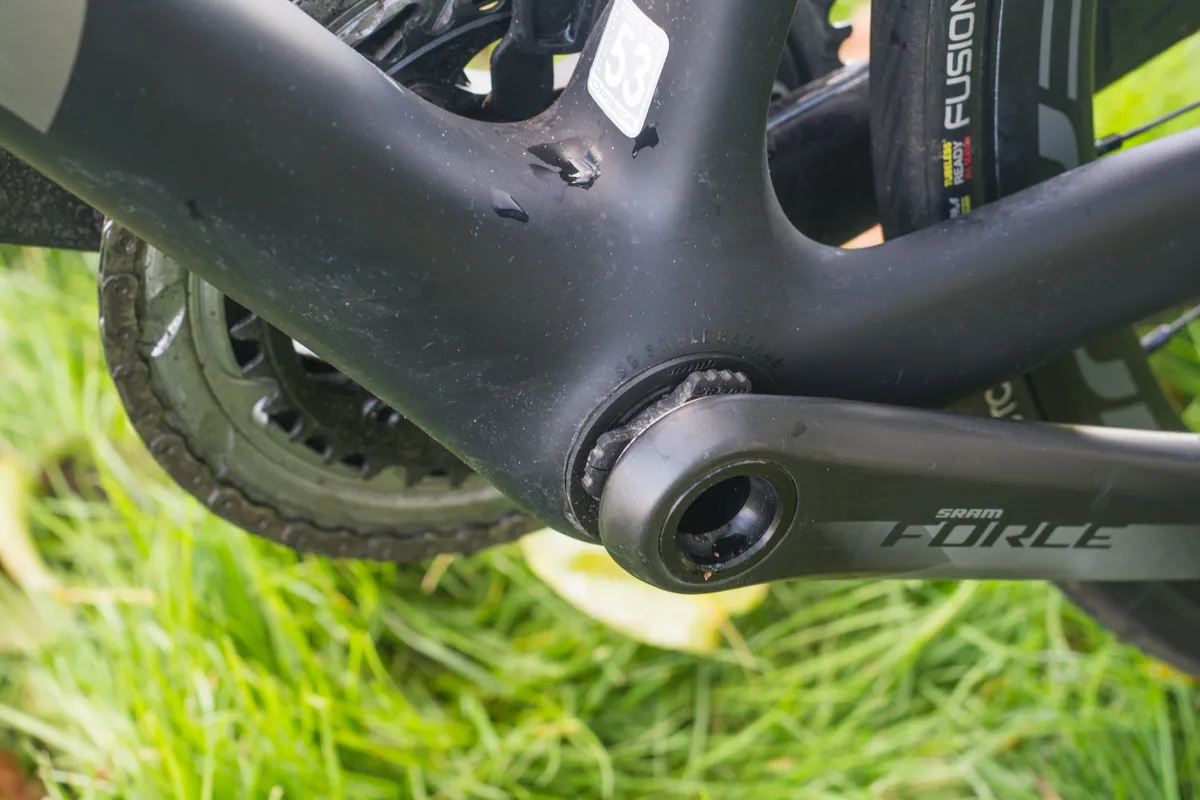
The matching XG-1270 cassette comes in 10-26t, 10-28t and 10-33t options. This means that the lowest gear achievable with Force eTap AXS is a 33/33t, while the highest is 48/10t (unless you opt for a more expensive Red crank).
The cassette fits on the XDR driver, the longer road version of the XD driver that SRAM launched to accommodate 10t cogs for its 1× mountain bike drivetrains.
There is just one Force eTap AXS rear derailleur so you don’t have to worry about cage lengths or chain capacity regardless of whether you’re running 2× or 1× – it’ll work as long as you keep everything within the AXS family, so to speak.
If you want even lower gears, there’s also the option to run road eTap AXS shifters with an Eagle AXS mountain bike rear derailleur.
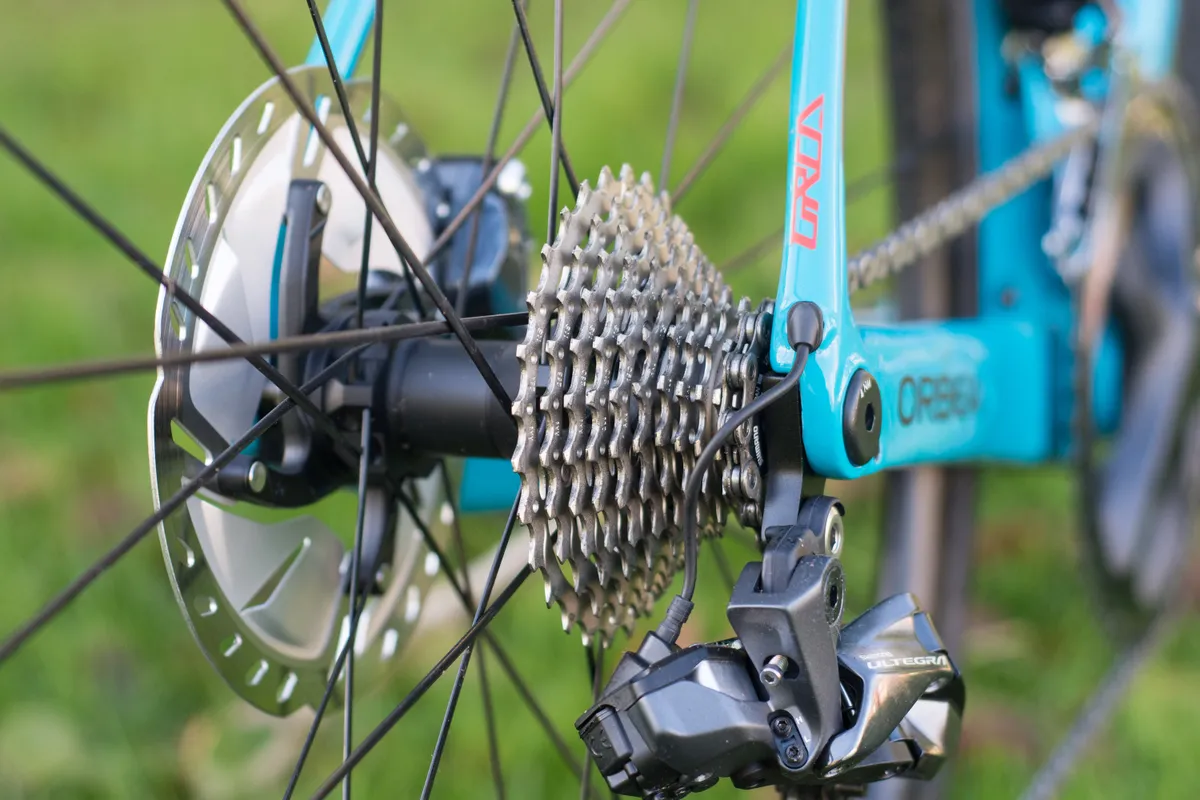
Shimano’s offering is much more traditional in terms of component choice. Ultegra R8070 Di2 offers exactly the same gearing options as mechanical Ultegra: 50/34t, 52/36t, 53/39t and 46/36t cranks, and 11-25t, 11-28t, 11-30t, 12-25t, 14-28t, 11-32t and 11-34t cassettes.
By default, Ultegra Di2 is 2×-only, although the launch of the GRX gravel range means Shimano does now offer groupset-compatible 1× bits, as well as some useful additional crank ratios.
You need to pay attention to compatibility, however. GRX cranks have a slightly wider chainline than standard road ones, and are meant to be used with GRX front derailleurs. All Shimano cranks work with the same Hollowtech II bottom bracket standard, which hasn't changed for years and works with all frames.
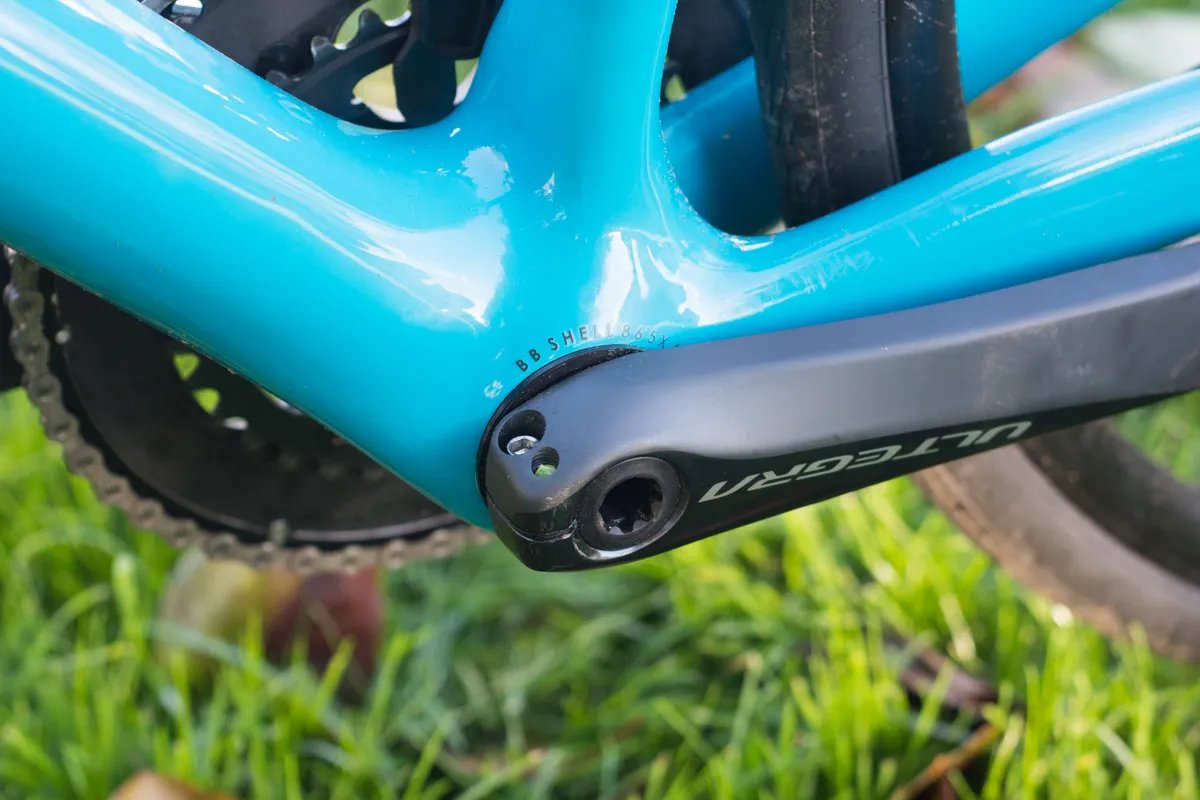
There are two R8050 Di2 rear derailleurs: the short cage (SS) version covers cassettes from 11-25t to 11-30t, while the medium cage (GS) option is suitable for those ranging from 11-28t up to 11-34t .
Which is better? SRAM, for its clean-sheet approach to gearing, overall versatility and across the board compatibility.
Di2 vs. AXS: brakes
For practical purposes, there isn’t much to choose between SRAM and Shimano’s disc brakes.
Shimano uses proprietary mineral oil as a brake fluid while SRAM uses DOT5.1. There are some theoretical performance advantages to DOT fluid but, on the road, you’re not likely to notice any difference in the course of regular riding.
In the workshop, it’s worth noting that DOT fluid can do a lot of damage if you spill it on a painted surface, so care needs to be taken when handling it. Day-to-day however, this is not an issue.
Shimano’s braking feels firmer at the lever, but both systems offer excellent braking in all conditions. One isn’t really better than the other.
One small difference is that, with the pads retracted (i.e. not squeezing the lever), SRAM’s pads run slightly closer to the rotor.
This means that rubbing is more likely in the event of a slightly bent rotor or when mud and grit get into the caliper. Most of the time, it makes no difference.
Which is better?: Shimano by a hair for its pad clearance, but there’s almost nothing in it.
AXS vs. Di2: connectivity
Both SRAM eTap and Shimano Di2 groupsets can be connected to third-party devices to customise specific features. Both can also be used as-is in their default modes without intervention, but this connectivity unlocks extra performance if you want it.
Force eTap AXS has one key advantage on this front – assuming you own a smartphone, you don’t need any extra hardware to interact with your groupset, as wireless connectivity is built-in.
Riders simply need to install the AXS app on their phones (it’s available for both Apple and Android devices) and they can then connect directly to the shifters and derailleurs to change settings and keep tabs on battery life.
The latter is particularly useful as, while the derailleurs run off batteries which are charged as part of regular maintenance, the shifters use single-use coin cells which need periodic replacement.
Ultegra Di2’s approach to connectivity is rather less straightforward. You can either make use of a wired connection via the Di2 charger (but this is Windows only; there’s no iOS option), or you can pony up for the EW-WU111 Bluetooth adapter, an additional £75 component that is not included with most Di2-equipped bikes.
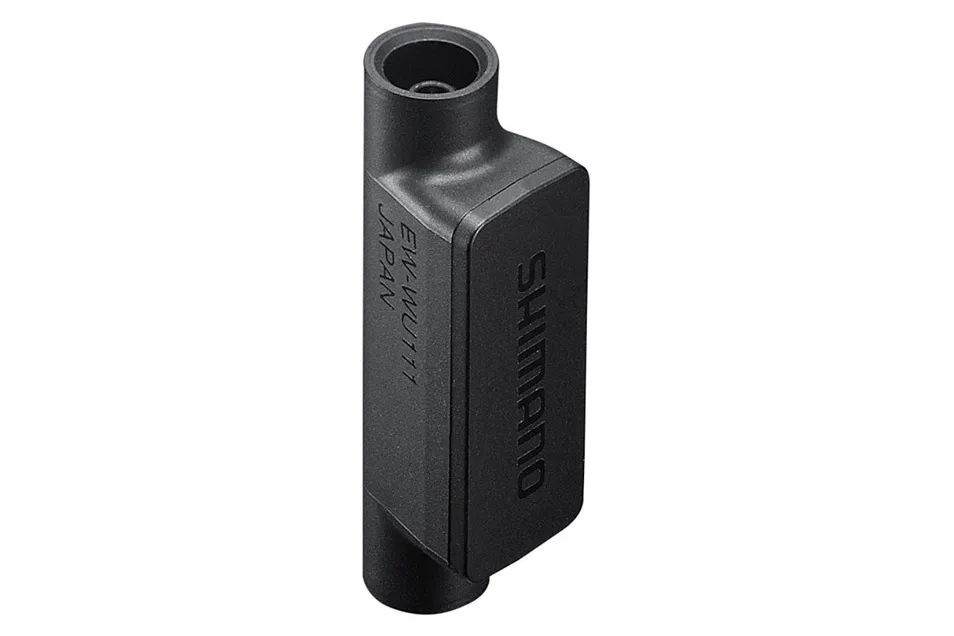
Shimano users may be slightly less likely to want the extra connectivity however, as both of the optional shifting modes are accessible via the button on the bar-end junction box now commonly included with the groupset, without any pre-programming.
Which is better?: SRAM, for its painless approach to connectivity that doesn’t require extra hardware.
Di2 vs. AXS: battery life and practicalities
With no gear cables to gum up or tension adjustments, both groupsets are pretty much fit and forget aside from standard maintenance such as lubing the chain and replacing worn consumables.
Both obviously need their batteries charging and this is one key area of difference. SRAM uses disposable coin cells in the shifters and separate removable rechargeable batteries for the derailleurs.
The coin cells last months or years (SRAM reckons around two years, but it’ll depend on usage) while the derailleur battery life is typically a matter of weeks.
If one derailleur battery goes flat, you can always swap the batteries round temporarily, choosing which derailleur you need to shift.
Shimano runs everything off a single, central high-capacity rechargeable battery that usually lasts months (Shimano claims at least 2,000km, typically 2,500 to 3,000km according to how often you shift) and is charged in-situ.
The slight danger with Shimano is that the battery requires charging so infrequently that it’s easy to forget about it completely, but it’s straightforward enough to check the state of charge via the indicator light on the main junction box so it’s on you if you flatten it.
Which is better?: It’s a draw. Neither groupset makes undue demands when it comes to keeping things charged.
AXS vs. Di2: weight
I don’t have verified weights for every individual component, however SRAM claims a complete Force eTap AXS HRD 2× groupset weighs 2,812g with 48/35t chainrings, 175mm cranks, a DUB BSA bottom bracket, a 10-28t cassette, flat mount calipers and 160mm rotors.
In its lightest standard configuration, Shimano claims an Ultegra Di2 R8070 groupset weighs 2,452g, however this figure rather cheekily omits the battery and all of the cables, which I estimate add around 110g based on figures supplied by Shimano.
A more typical choice of gearing (11-28t instead of 11-25t) and 160mm (rather than 140mm) rotors will bring the total up by a further 60g or so, for a total estimated weight of approximately 2,620g.
(This figure will still vary according to how you configure your groupset of course – cables are available in varying lengths, and some riders will opt to include extras such as satellite shifters and the EW-WU111 Bluetooth interface.)
There are a great many variables in choosing both groupsets, but it does appear that the disc version Ultegra Di2 is slightly lighter than Force eTap AXS HRD; a difference of perhaps 190g or so.
In the scheme of things, this is a pretty trivial difference, and it absolutely would not be a factor in choosing between the groupsets for me.
Incidentally, if you’re wondering why I don’t simply quote the weights of our Orca test bikes, that’s because, aside from the groupsets, they don’t have identical builds, so to do so could be misleading.
Which is better?: Shimano, but there’s really not much in it, and it depends exactly what configurations you’re comparing.
Di2 vs. AXS: Price
Retail pricing for the two groupsets is as follows. This comes with a significant caveat, however – there's aggressive price competition online, so you'll rarely see or pay RRP.
To reflect this and give a better real-world comparison, I've included the best prices I could find from UK retailers at the time of writing. These are based on equivalent groupset specs.
However, they are imprecise figures as retailers typically group SRAM and Shimano components differently, with few offering a complete Force eTap AXS groupset including both shifting and drivetrain components.
Also, most off-the-peg Ultegra Di2 groupsets include the basic under-stem junction box rather than the more desirable EW-RS910 bar end unit featured on my test bike, which is considerably neater.
- SRAM Force eTap AXS HRD 2×: RRP £2,274 / $2,678, real-world price from approx £1,650
- Shimano Ultegra Di2 R8070: RRP £2,004.81, real-world price from approx £1,330
SRAM Force eTap AXS vs. Shimano Ultegra Di2 R8070: which is better?
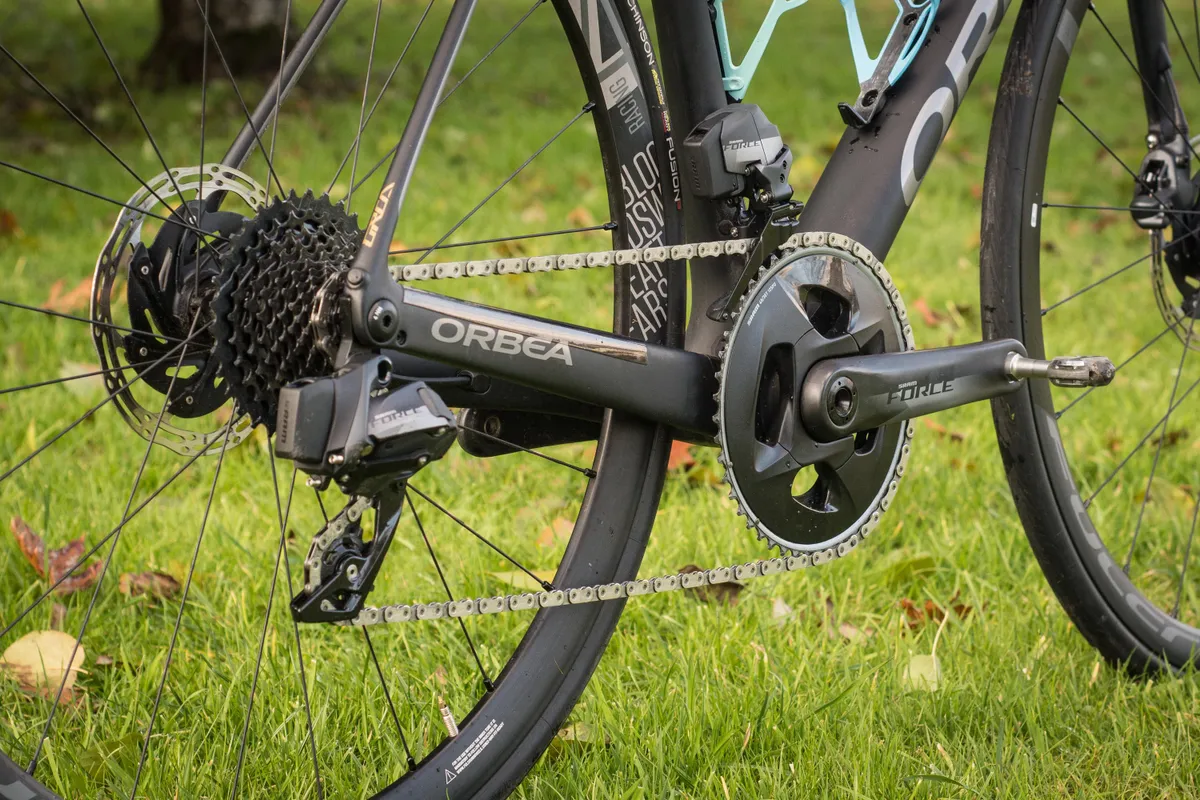
On paper, SRAM seems like a clear winner. It’s got one more gear, it’s easier to set up and it offers straightforward Bluetooth connectivity with no extra parts.
If you’re building a bike from scratch, SRAM’s component options are far less confusing than Shimano’s, with fewer compatibility pitfalls and none of the head-scratching over wiring arrangements.
Having said that, there are still valid reasons why one might prefer Shimano.
For starters, Ultegra Di2 is currently cheaper than Force eTap AXS, around £300 less when comparing real-world prices.
Also, I do feel that Ultegra Di2 looks better overall than its rival, despite not offering the neatness of a wireless groupset.
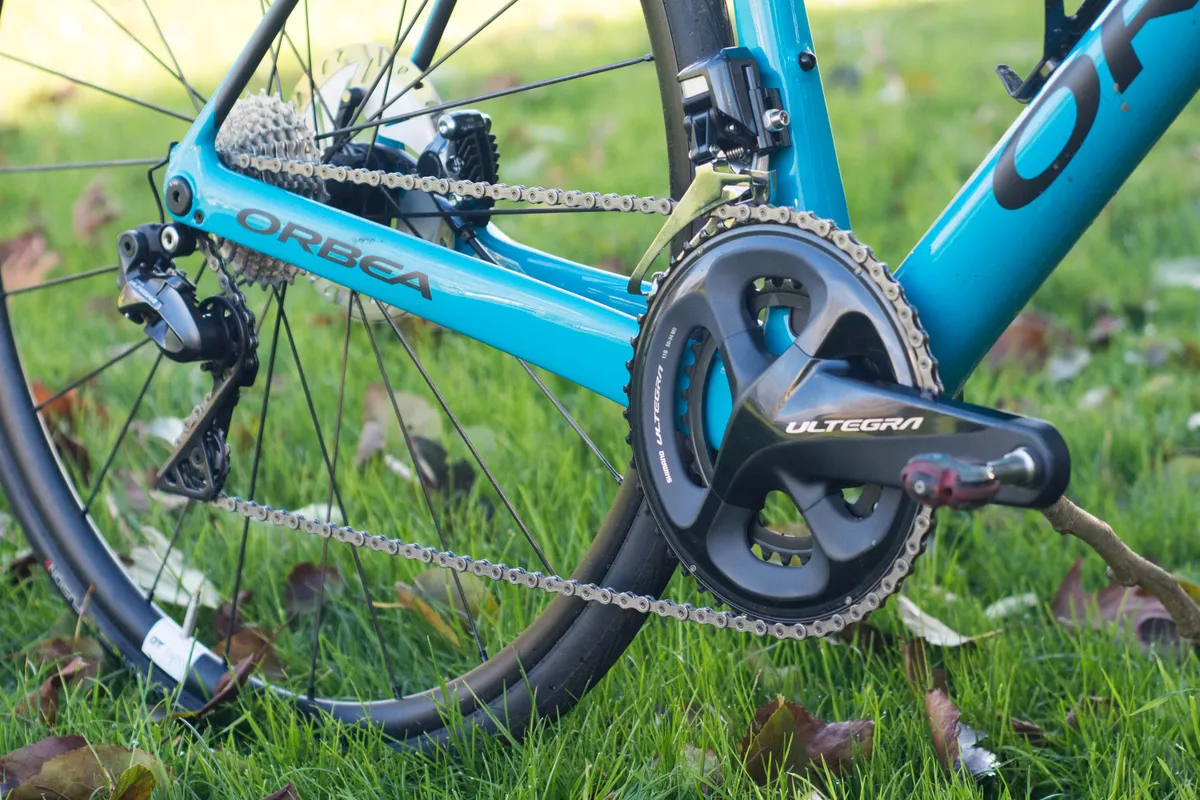
The finish is more luxurious and the levers are less bulbous and have a reassuring solidity to them.
That’s quite subjective, however – some riders will doubtless prefer the less glossy styling of Force and if you want wireless then there’s clearly only one choice.
Ultegra Di2 appears to be lighter than Force eTap AXS, but the difference is small enough that it wouldn’t be a deciding factor for me – both groupsets are light enough.
SRAM’s ultra-simple shifting arrangement is a delight, but not all riders will like the double-press required for a front derailleur shift, preferring dedicated buttons for each shifting action.
Ultimately, Force eTap AXS and Ultegra Di2 are both excellent groupsets and choosing between them will come down to personal preference to a significant extent.
My ideal electronic groupset would offer the gearing options and clean wireless design of AXS along with its user-friendliness, but add in the slick packaging and premium looks of Di2.
Which groupset would you rather have on your bike? Let us know your thoughts in the comments.
